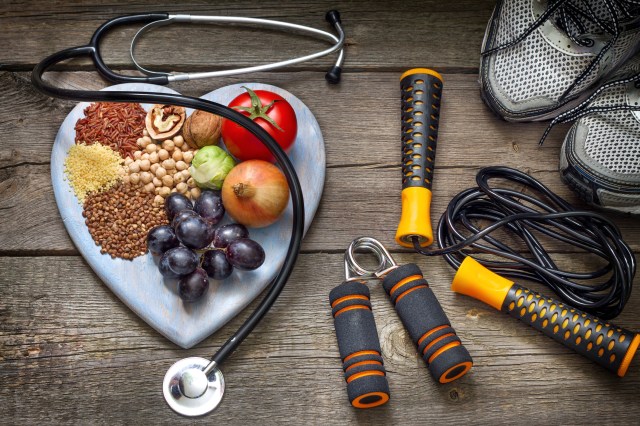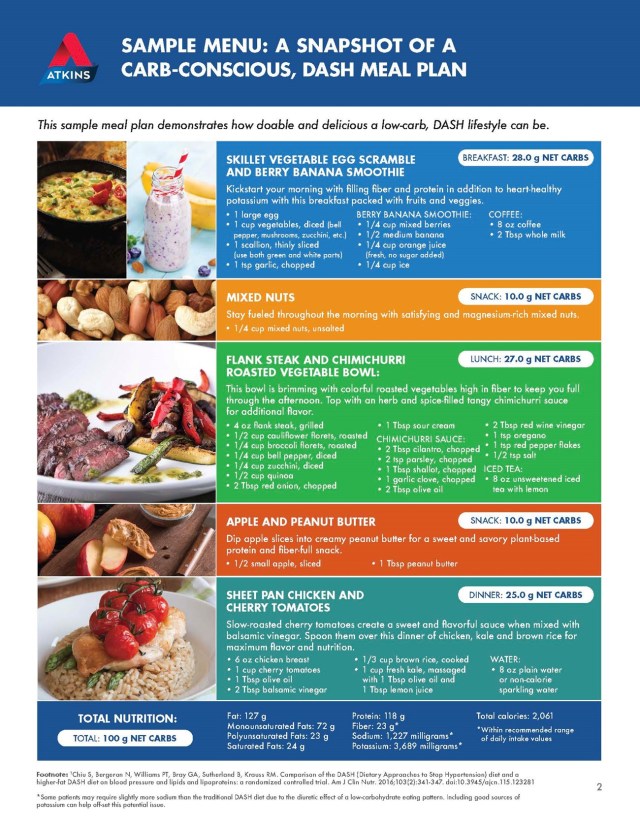
- What is the DASH diet?
- What do you eat on the DASH diet?
- The DASH diet eating plan
- How the DASH diet compares to Atkins 100™
- How to do the DASH diet on Atkins 100
- 6 tips for a low carb DASH diet
- A low carb DASH diet menu
Atkins 100™ and the DASH diet
The DASH diet is a low-sodium, low-fat, high-fiber approach that was developed to help support lower blood pressure and healthy cholesterol levels.
What is the DASH diet?
The National Heart, Lung and Blood Institute’s Dietary Approaches to Stop Hypertension—the DASH diet—is a low-sodium, low-fat, high-fiber approach that was developed to help lower blood pressure and cholesterol. The DASH diet is sometimes recommended by doctors to help treat high blood pressure or hypertension, which affects 1 in 3 American adults. Untreated high blood pressure may lead to heart disease, stroke, congestive heart failure, kidney disease and blindness.
The DASH diet had its debut at a meeting of the American Heart Association in 1996. In 1997 it was published in the New England Journal of Medicine.
What do you eat on the DASH diet?
The sample meal plans for the DASH diet provided by the National Heart Lung and Blood Institute (NHLBI) are based on 1,600, 2,000 or 2,600 calories daily.
The DASH diet eating plan
The DASH diet recommends:
- Eating fruits and vegetables that contain nutrients that help lower blood pressure, such as magnesium, potassium and other phytochemicals.
- Eating whole grains, beans, nuts and vegetable oils.
- Eating fat-free and low-fat dairy products.
- Eating primarily lean poultry, fish and seafood.
- Limiting foods high in saturated fat, such as fatty meats, full-fat dairy and tropical oils such as coconut, palm kernel and palm oils.
- Limit sugar-sweetened beverages and sweets and anything containing elevated sodium levels.
A 2,000-calories-a-day DASH diet eating plan would look like this:
- 6-8 servings of grains or grain products (whole grains are recommended)
- 4-5 servings vegetables
- 4-5 servings of fruits
- 2-3 servings of low-fat dairy foods
- 2 or fewer 3-ounce servings of meat, poultry or fish
- 2-3 servings of fats and oils
- 4-5 servings of nuts, seeds, or dry beans per week.
Limit sweets and added sugars to 5 servings or less per week
How the DASH diet compares to Atkins 100
While there is no set macronutrient range on the DASH diet, about 55% of the daily calories come from carbs, which is more than you eat on Atkins 100. The DASH diet also recommends low-fat or fat-free dairy products and to limit saturated fat, but within the context of a low carb lifestyle like Atkins 100 (or Atkins 20® and Atkins 40®), research has shown that the saturated fat in these foods is not harmful:
- A 2007 study in Lipids one group of participants followed a low carb diet and consumed three times the levels of saturated fats, while a second group of participants followed a low-fat diet. After 12 weeks, both groups lost weight, but the low carb group had lower saturated fat blood levels than the low-fat group, even though the low-fat group consumed less saturated fat.
- In a 2008 study in Progress in Lipid Research, a group of average-weight men who typically consumed the Standard American Diet (SAD) as recommended by the U.S. Dietary Guidelines, followed a low carb diet consisting of about 80 to 100 grams of Net Carbs a day, which contained more saturated fat than the diet they had been following. After six weeks, despite consuming more saturated fat than they had previously, the men showed a significant reduction in their blood levels of saturated fat, and they also improved their triglyceride and HDL cholesterol levels, LDL particle size and insulin levels.
How to do the DASH diet on Atkins 100™
Atkins 100 is intended as a long-term lifestyle, which means flexibility is essential. With 100 grams of Net Carbs (total carbs minus fiber) each day, Atkins 100 can be customized fit almost anyone’s food preferences or healthy eating pattern, including the DASH diet.
Research shows a reduced-carb, higher-fat approach to the DASH diet not only helps lower blood pressure to the same extent as the original DASH diet, but also lowers plasma triglycerides and VLDL levels without significantly raising LDL cholesterol, based on a 2016 study in The American Journal of Clinical Nutrition, which tested the effects of a traditional DASH diet and a modified DASH diet using high-fat dairy products. The authors of the study concluded: “the results of this study indicate that modification of the DASH diet to allow for more liberal total and saturated (fats?) in conjunction with moderate limitation of carbohydrate intake, primarily from fruit juices and sugars, results in lower concentrations of triglycerides and VLDL particles, with no increases in total or LDL cholesterol and no attenuation of the favorable blood pressure response to the standard DASH diet.”
Here’s what you eat on a low carb DASH diet:
- A variety of heart-healthy protein sources, including:
- Eggs
- Fish and seafood, such as cod, haddock, pollock, flounder, halibut, tilapia and orange roughyroughly
- Lean meat (such as sirloin or tenderloin) and pork
- Full-fat dairy (dairy products higher in fat contain less sugar and are more satisfying because of their fat content)
- Lean poultry such as skinless chicken or turkey breasts
- Tofu and plant-based crumbles and burgers
- Nuts and seeds, such as pepitas and hemp seeds, which are healthy sources of omega-3 fats
- Fiber-rich vegetables and fruits including those high in potassium and other phytonutrients, which may help blood pressure:
- Salad greens
- Cauliflower
- Mushrooms
- Tomatoes
- Bok choy
- Broccoli
- Spinach
- Apricots
- Bananas
- Avocado
- Berries
- Garlic
- Whole grains, such as:
- Whole-grain bread and pasta
- Whole oats
- Brown rice
- Bulgur
- Quinoa
- Barley
- Millet
- Couscous
- Popcorn
6 tips for a low carb DASH diet
- Eat about 12 to 15 grams of Net Carbs of fiber-rich vegetables a day. This is about 6 to 8 portions
- Eat about three 4- to 6-ounce servings of protein a day
- Eat two to four servings (1 tablespoon) of healthy fats a day, such as olive oil, canola oil, flaxseed oil or coconut oil.
- Get the remaining 85 grams of Net Carbs from servings of low-glycemic fruit such as berries, cheese and dairy, nuts or whole grains.
- Keep your portions whole grains small: Swap half a portion of brown rice with cauliflower rice or replace half a portion of whole-grain pasta with zucchini “noodles”
- Eliminate the salt in any recipe and boost the flavor with fresh herbs and spices.
A low carb DASH diet menu
